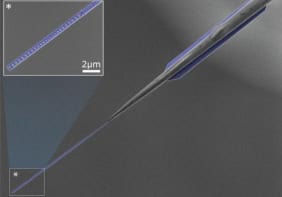
Few claims about metallic states of superdense hydrogen go unchallenged, and the latest is no exception. Two researchers at Harvard University in the US today report the observation of an electrically conducting liquid in the element compressed in the laboratory to extremely high pressures. They say their liquid metallic hydrogen might be like the stuff in the interiors of gas-giant planets such as Jupiter and Saturn, and fits with recent observations of Jupiter’s magnetic field. But other experts question these interpretations.
The idea that hydrogen might become metallic at high pressure goes back to a theoretical proposal in 1935. Such a high-pressure solid phase has been sought ever since, boosted by the suggestion in 1968 that this solid might be superconducting at room temperature. No one has convincingly seen such a state, although in disputed work published earlier this year, Isaac Silvera and Ranga Dias at Harvard claimed to have made it.
But liquid hydrogen should be metallic too at high pressure, and evidence for that was reported back in the mid-1990s. Now Mohamed Zaghoo, working with Silvera at Harvard, says that their observations of liquid hydrogen squeezed to up to 140–170 gigapascals (1.4 million atmospheres) in a high-pressure diamond anvil cell and laser-heated to temperatures of 1800–2700 K “reveal it to be much more conductive than previously thought.”
As the hydrogen sample became metallic, they noticed its reflectance increase sharply. “At a certain transition temperature, the reflectance abruptly rose to 50–55%, values typical of metallic behaviour,” says Zaghoo. The researchers calculated the conductivity from this reflectance, assuming that it is a simple metal with free electrons. They found it to be 5–7 times higher than a value measured for shock-compressed liquid hydrogen in 1996.
Confirmed by Juno?
The existence of such a metallic state inside Jupiter is, Zaghoo says, thought to be the reason the planet possesses a magnetic field. “The immediate implication [of the result] is that the magnetic field of Jupiter ought to be stronger than previously held,” he says. “And the field also should originate much closer to the surface than assumed.” Zaghoo comes to this conclusion because their experimental conditions are like those at a radius 84% of the full planetary radius, and the researchers estimate that the planetary dynamo layer may in fact extend out to at least around 91% of the radius.
That makes it much closer to the outer surface than previously thought. But Zaghoo says that, after he and Silvera posted a preprint of their paper on the arXiv in January, “much to our amazement, only a few months later the Juno space mission results came out confirming exactly what our experiments was suggesting.”
Open to question
Not everyone is convinced, however. Planetary scientist David Stevenson of the California Institute of Technology in Pasadena feels that the new result does not add significantly to this picture. “Their experiments are not for the conditions of relevance to the outer region of Jupiter,” he says. “What they did is extrapolate outwards to lower pressure, and this is debatable.”
Meanwhile, William Nellis, a high-pressure experimentalist who works at Harvard independently from Silvera’s group and reported the earlier, lower value of the liquid-phase conductivity, argues that the authors have found a different liquid conductive region from the one he saw, because the two regions were prepared by different techniques. They can’t be the same phase, he says, because they have different densities.
However, the earlier measurement is reliable, he says, because that conductivity was measured by direct electrical probing, whereas “to derive conductivity from a free-electron theory can introduce unknown systematic errors.” If two such phases exist in this region of the phase diagram, the question of which might be relevant to planetary conditions remains open.
- For more on the claims surrounding liquid metallic hydrogen, check out our feature “Show us your metal”



